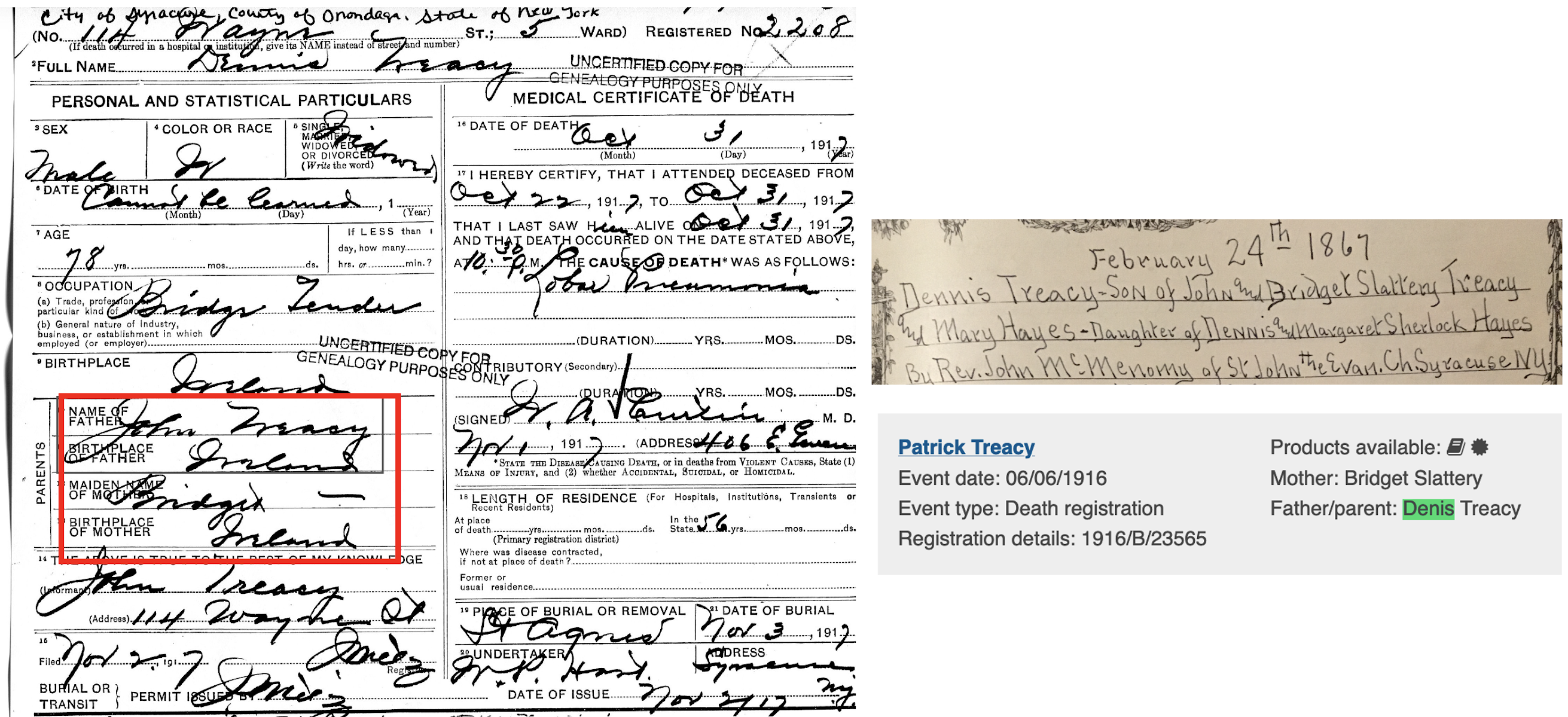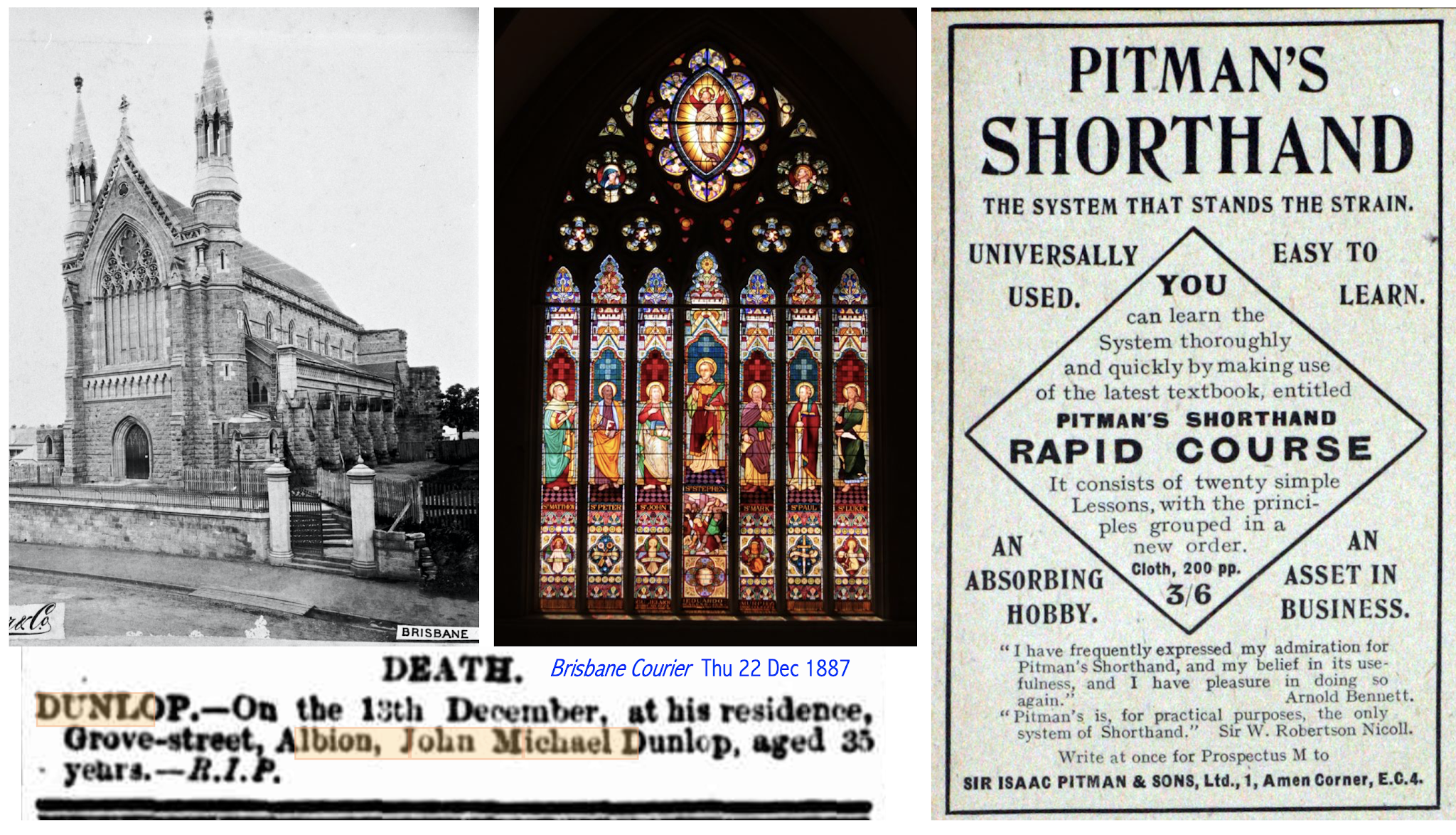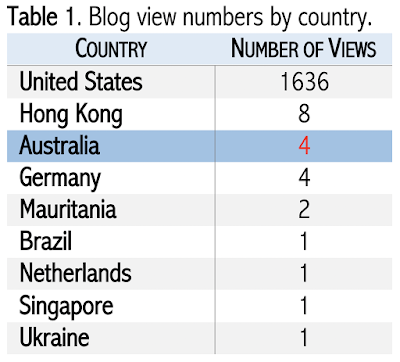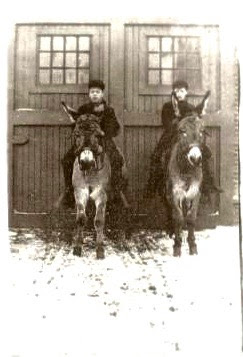UPDATE 1: The section on James Canice O'Leary was updated on Wed 16 Dec 2020.
UPDATE 2: Figure 8b showing the gravestone of James F. Dunlop was added on Fri 18 Dec 2020.
Today's blog post is about our distant Australian cousins. In my New Year's Day 2020 post discussing our immigrant ancestors, Dennis Treacy & Mary Hayes, I mentioned in passing that Dennis' only brother Patrick immigrated to Australia. Here I report on his descendants and raise some open questions.
My genealogy research on my dad's side has been greatly assisted by the detailed notes my grandmother Anne (Treacy) Fenlon kept. The data contained in them has proven very accurate and the only mistakes I have found are some different middle names for one or two distant cousins. I am very grateful to uncle Brian for mailing them to me a few years ago and recently Uncle Tim also sent me a copy! Figure 1 shows Anne's notes for Dennis' parents and siblings. This tree gave me all the key information I needed to use the rich genealogical resources of the internet to investigate and flesh out the lives of our Aussie cousins.
 |
| Figure 1. Anne (Treacy) Fenlon's records for the children and grandchildren of John Treacy and Bridget (Slattery) Treacy. * Indicates our branch of the Treacy tree. |
It is interesting that six of John and Bridget Treacy's children lived to adulthood and 5/6 decided to leave Ireland, as only Hannah remained. The oldest child Mary immigrated Canada. Bridget, Dennis (my GG grandfather), and Julia II immigrated to the Syracuse, NY area. Patrick is the only one to immigrate to the southern hemisphere, where he settled in South Brisbane, Australia. Brisbane is in the State of Queensland and is on the central east cost of the country, see Figure 2.
Before we begin looking at the lives of our distant cousins, it is useful to clarify our connection. Figure 3 shows a relationship chart between James F. Dunlop and me. My grandmother Anne (Treacy) Fenlon was a second cousin to James, which makes me his second cousin twice removed.
 |
Figure 3. Relationship chart showing that James F. Dunlop is my second cousin twice removed.
|
|
Patrick J. Treacy & Margaret Agnes Connolly
Patrick J. Treacy (b. ~1840) met and married his wife Margaret Agnes Connolly (b. ~1836) in Ireland where their oldest child Mary was born in 1863. They immigrated to Australia ca. 1864. For comparison, Patrick's older brother Dennis immigrated to the US in 1861. Between 1864 and 1872 Patrick and Margaret had four children born in Australia: one son and three daughters (Figure 4).
 |
| Figure 4. Family tree of Patrick and Margaret (Connolly) Treacy. |
Margaret was older than Patrick and she also died before him, on 24 Jan 1892. She was only 56 years old. Patrick died in Brisbane on 6 Jun 1916, he was about 76 years old. They are both buried in Toowong Cemetery near Brisbane. Margaret's gravestone and funeral notices for Patrick are shown in Figure 5. Patrick and and Margaret lived on Russell Street in South Brisbane. As can be seen in the funeral notices, their home appears to be nicknamed "Glenfaba," which is also the name of a region on the Isle of Man in the UK. I am not sure how this nickname arose although it appears to be a common practice based on other newspaper articles.
 |
| Figure 5. Margaret (Connolly) Treacy's gravestone. Newspaper funeral notices for Patrick Treacy. |
Before discussing in detail the children of Patrick and Margaret, I note that Patrick's father is listed as Denis in this FamilySearch tree (Figure 4) I found online, whereas my records indicate his name was John. From what I can tell the tree in Figure 4 was created using cemetery and Queensland governmental records by FamilySearch and BillionGraves user Donna J. Sullivan. In the Queensland death record for Patrick, his father is listed as Denis whereas the Onondaga County death record for my GG grandfather Dennis (Patrick's brother) and the Treacy family bible both show their father's name as John (Figure 6). I assume John is the correct name as my great grandfather John Treacy was the one who filled out the Onondaga County death certificate and I assume his father Dennis had told him he was named after his grandfather. To further investigate this I need to order the death certificates for Julia (Treacy) Moriarty and Bridget (Treacy) Gleason. I think Julia died on 16 Apr 1907, but I need to confirm this before paying for the death certificate search.  |
| Figure 6. Onondaga County, NY death certificate for Dennis Treacy and the Treacy family bible showing Dennis' father's name as John. The death record from Queensland, AUS showing Patrick and Dennis' father's name as Denis. |
I will now discuss Patrick and Margaret's five children, and their families, in order of their birth.
1. Mary Josephine Treacy
Their first-born was Mary Josephine (~1863 - 3 Feb 1931) who was born in Ireland and brought to Australia as an infant. She married John Michael Dunlop on 29 Jun 1885 (in the cool of winter) at
St. Stephen's pro-Cathedral in Brisbane (Figure 7). Two years later the Dunlops welcomed their first-born and only child
James Francis Dunlop (15 Aug 1887) into the world. Later that same year, Mary's husband John died; he was only 35 years old. This left Mary to raise her son James as a single mother. Mary went to school to learn shorthand and later would find employment teaching shorthand as a private coach. A 1911 newspaper ad read, "
MRS. Dunlop, private Tuition in music, piano, and theory; also shorthand and typewriting, positions found for students, when competent, terms. Apply Glenfaba, Russell street, South Brisbane." This ad suggests that Mary and her son James lived with her parents in 1911. Mary learned and taught the Pitman shorthand method, which was more popular in most of the world, whereas Mary (Treacy) Degan (Mary Dunlop's her first cousin once removed) likely learned Gregg shorthand as that was taught in the US.
 |
| Figure 7. St. Stephen's Pro-Cathedral in 1889 in Gothic Revival style. The stained glass window in St. Stephen's (35 feet tall x 14 feet), completed in Dec 1885. Newspaper notice of the death of John Michael Dunlop in 1887. Advertisement for Pitman's School for shorthand in London in 1918. |
When I first started investigating the Dunlops I saw that, like his father, Mary's son James died very young. He died on 16 Aug 1918, one the day after his 31st birthday. If you know history and you see a death date of 1918, then you think one of two things: influenza or World War I (WWI). The 1918-1919 influenza pandemic (
the term Spanish flu is a misnomer, a good case can be made for
Kansas as the origin) is estimated to have killed 50-100 million people worldwide, while WW1 civilian and military causalities are estimated at ~20 million people. So, if you were betting based on these numbers, you would guess James died of the flu. In investigating further, I noticed an interesting inscription about James on his mother Mary's gravestone in Toowong Cemetery: "JAMES FRANCIS, of the Royal Engineers, Buried in Canterbury Cemetery, England" (Figure 8a).
UPDATE: On 18 Dec 2020 Find-A-Grave user JOL generously responded to my request for a photo of James' gravestone in the Canterbury Cemetery, Kent, UK. It is shown in Figure 8b.
It turns out the
Royal Engineers were a unit in the Australian army and James was in the military with the rank of Sapper. The term
sapper originates from engineers that dug tunnels (saps) and trenches, but military records show James was in the "Inland Waterways and Docks" division. With this information I then assumed that James died in a WW1 battle and since he died in August of 1918, I was all set to tell you about the
Battle of Amiens. But, then I found the obituary for James' mother Mary and it told the whole story. It is shown in full in Figure 9.
 |
| Figure 8a. Mary J. (Treacy) Dunlop in 1908. Mary's gravestone. Seal and motto of the Royal Australian Engineers. |
 |
| Figure 8b. James F. Dunlop's gravestone from Canterbury Cemetery in Kent, UK. The inscription states he was 28 years old, but Australian birth records put him at 31 years old. |
 |
| Figure 9. Mary Dunlop's obituary from the Brisbane Courier 10 Feb 1931. |
The obituary is remarkable for many reasons. It establishes that Patrick, Margaret, and Mary had lived in
Ballinasloe, County Galway before immigrating to Australia. Amazingly, it describes her son James living in New York ca. 1905-1914, and Mary joining him there and later they moved to London when he joined the Royal Engineers. It also shows that James died of influenza, despite being in the Australian military during WW1. The Jewish college that Mary worked for ca. 1915 was likely what is now known as the
London School of Jewish Studies, but was formally called Jews' College. In terms of Mary's home when she died, Edmundson Street intersects with Russel Street in South Brisbane.
I searched the Cornell Daily Sun newspaper and The Cornellian yearbook to find a record of James attending Cornell College of Engineering, but came up empty. This surprised me and so I also explored the records of Cornell College in Iowa and even Columbia University in NYC, just in case the obit was inaccurate. None of these efforts yielded any results. In contrast to this, I can find many military records for James.
2. Michael Joseph Treacy
The second-born child of Patrick and Margaret was their only son, Michael Joseph (26 Sep 1864). I know very little about Michael. He lived in Ingham in 1936. Later he moved to Redlynch and he died in Cairns on 31 Jul 1946 and is buried in Cairns Cemetery.
3. Honora (Nora) Adelaide Treacy
The third-born child of Patrick and Margaret was Honora Adelaide, who went by Nora / Norah (16 Apr 1866 - 19 May 1956). Nora never married and I know very little about her. A newspaper photo of "Miss Treacy" appeared in 1908 in the Queenslander (Figure 10). This is either Nora or her sister Bridget. Nora was the last person in her immediate family to die, so she left £ 5000 to the Pope. Conversion of this gift to today's US dollars is complicated by the fact that Australia switched its currency from Pounds to Dollars in 1966. Accounting for this and inflation, the bequest is approximately equivalent to $70,000 today. The newspaper article about this gives her reasons for bequeathing this large amount of money to Pius XII, but his actual record on matters relating to WW2 is debated by historians.
 |
| Figure 10. "Miss Treacy" in 1908, it is either Nora or Bridget. Newspaper article from Jan 1957 on the £5000 gift to Pope Pius XII from Nora's estate. |
4. Bridget (Bridgie) Catherine Treacy
The fourth child of Patrick and Margaret was Bridget Catherine Treacy, who went by Bridgie (12 Feb 1869 - 4 Jul 1950). Like Nora, Bridgie never married. She worked as an inspector for the Ration Relief Department from ca 1909 until late 1929. She was only 60 years old when she was forced to retire because of ill health. From what I can gather from newspaper articles, she was well respected and did social work similar to work done by the Department of Children and Family services here in the US. The Truth newspaper profile of Bridgie upon her retirement is shown in Figure 11.
 |
| Figure 11. Profile of Bridgie Treacy's career with the Ration Relief Department published in Truth on 27 Oct 1929.. |
The story about the revolver is the most amazing one to me, but in several articles Bridgie says her favorite is the baby bonus comment. I do not get the joke with this one and I expect I am missing the appropriate context. My guess is that the government provided funds to a family when a new baby was born, but I'm not sure why this is "a gem." One story that did not make this profile happened earlier in 1929. A 46 year old laborer named George Thwaites was given a seven day prison sentence for stealing Bridgie's fountain pen. Thwaites went to the Relief Depot for rations and Bridgie refused to sign his ticket as he was "under the influence of liquor." After Thwites left she was missing her pen. Bridgie confronted him on the street and at first he denied taking the pen, but later he admitted the theft and was given the sentence by the Chief Police Magistrate.
Starting in 1918 Bridgie gave the Dunlop Medal annually to the local student who exhibited "all-round progress and merit." The prize was given "in memory of her nephew, the late James Francis Dunlop, of the Royal Engineers, who died on service in England." The first recipient of the Medal was James Cullen.
The last story I have regarding Bridgie is related to her sister Clara's wedding (see below for more on Clara). I found a newspaper gossip column from 13 Apr 1905 that stated, "Miss B. Treacy, Russel Street, South Brisbane, left by the Wollowra on Tuesday for Cairns. Miss Treacy will act as a bridesmaid at the wedding of her sister." A Google search reveals that the Wollowra was a steamship in operation at this time. Another newspaper story (from 1904) brags about how the ship only took 69 hours (almost 3 days) to travel from Brisbane to Cairns (Figure 12). By way of comparison, if you were to make this journey today by car using the Bruce Highway / A1 toll road it would take about 19.5 hours to cover the 1045 miles. By bus it would take about 30 hours and by plane only 2 hours.
 |
| Figure 11. The SS Wollowra that Bridge took from Brisbane to Cairns in Apr 1905 to attend her sister Clara's wedding. |
Bridgie died on 4 Jul 1950 and is buried in the Toowong Cemetery with her parents and older sisters (Figure 12).
 |
| Figure 12. Bridget Treacy's gravestone in Toowong Cemetery and her obituary. |
5. Clara Frances Treacy
The youngest child of Patrick and Margaret was Clara Frances Treacy (22 Feb 1872 - 15 Jul 1936). Clara moved north to Cairns in 1903, perhaps because of a job. While there she met widower John Joseph O'Leary (~1854 - 7 Mar 1933). Several photos of John are collected in Figure 13.)
John married his first wife Mary Finn (unk - 10 Nov 1902) in 1888. They had at least two children: Gerald Dick O'Leary (14 Jan 1890 - 10 Oct 1961) and Elsie O'Leary (4 Dec 1891 - 14 Jun 1970).
Clara and John were married at St. Monica's Church on 24 Apr 1905 by Rev. Dr. Murray, Bishop of North Queensland (Figure 14).
 |
| Figure 14. Newspaper account of the wedding of Clara Treacy and J. J. O'Leary. 1884 photograph of the first St. Monica's Church. This building was destroyed by Cyclone Willis in 1927. The Right Rev. Dr. James Murray (born in Wicklow, Ireland in 1828). |
Clara and John had four children between 1907 and 1916. Their sons Kevin, Desmond, and James lived to adulthood, but their daughter Mercia O'Leary (20 Nov 1916 - 2 Mar 1917) died as an infant. Below I provide the limited information I have on their sons, but first I will discuss John and Clara more.
John J. O'Leary moved to Cairns in 1880 and was considered a pioneer in that region. When he died, several newspaper stories and tributes were published about him. One of them is shown in Figure 15. His legacy was so significant that the Cairns Shire Council erected a marble tablet in his honor and a street is named after him in the Cairns suburb of Westcourt (Figure 16).  |
Figure 15. Profile of John Joseph O'Leary from the Northern Herald on 11 Mar 1933.
|
 |
| Figure 16. Text of tablet posted by Cairns Shire Council. O'Leary Street in Cairns is named for J. J. O'Leary. |
Clara (Treacy) O'Leary died three years after John, she was 64 years old (Figure 17). They are both buried in Cairns Cemetery.  |
| Figure 17. Clara (Treacy) O'Leary obit that appeared in the Northern Herald on 18 Jul 1936. |
Kevin Patrick O'Leary, the first child of John and Clara, was born on Christmas day 1907. He was a banker and then served on the clerical staff for the Board of a hydroelectric company. He died on 4 Oct 1936, he was only 28 years old. His obituary is shown in Figure 18. The HACBS organization mentioned is the Hibernian Australian Catholic Benefit Society.
 |
| Figure 18. Obituary for Kevin O'Leary from the Cairns Post on 5 Oct 1936. |
Desmond John O'Leary, the second child of John and Clara, was born on 6 Sep 1909. I know very little about Desmond. Like his brother Kevin, he appears to have excelled in school as there are newspaper articles that list his test scores: regarding examinations at St. Joseph's Nudgee College (a school for 5th through 12th grades located in Brisbane) a newspaper article from Jan 1926 noted that Desmond "entered and passed eight subject, including three merits." Unfortunately I do not know whether Desmond married or when he died.
James Canice O'Leary (1 Jul 1912 - 10 Jan 1957) was the third child of John and Clara. He was a solicitor (lawyer) practicing in Brisbane. His name appears in a few newspaper articles regarding legal disputes. In 1951, he represented a Miss Laura Chadwick as she sued Mr. Charles Donald Smith for an alleged breach of a promise of marriage. In 1952, he won his appeal against a fine of £5 for failure to answer a letter from the Queensland Law Society within the prescribed time. In 1954, he was involved in dispute over who will be the executor of the will of a chemist (pharmacist) named Colin James Geddes. He is buried in the Nudgee Cemetery in Brisbane.
UPDATE: On 15 Dec 2020 the Find-A-Grave website memorial for James (linked above) was edited and a photograph of the gravestone was added (Figure 19). It appears that James did marry because the name Mary Cecelia O'Leary and death date (9 Jan 1984) of his apparent wife are shown on the same gravestone. Mary was the daughter of Nicholas Joseph Nolan and Catherine Cecelia (Thompson) Nolan and was born 17 Jul 1907 , making her older than James.
 |
| Figure 19. Gravestone for James Canice O'Leary and his wife Mary Cecelia (Nolan) O'Leary. |
John Joseph O'Leary's brother Michael O'Leary was also considered a "pioneer" in Cairns. He was a gold prospector and famous journalist in Queensland. Open Questions
I learned so much in researching our cousins, however, as is the case with most research, this only led to new questions. The three questions below and others may have come to your mind as you read this post. Please leave a comment or email me if you want me to investigate other questions.
1. Do we have any living Australian cousins? My research did not reveal any children for Kevin, Desmond, or James O'Leary or for James Dunlop. It is possible I missed them, especially for Desmond or James O'Leary. It is also possible that Michael Treacy had children. I have evidence that John J. O'Leary's son Gerald from his first marriage had children, but they would not be blood relatives.
If we do have relatives, perhaps they have visited this blog. When I started blogging I did not know Google would provide general data on visitors. I was pleasantly surprised to learn that not only are the number of visitors logged, but also their country location. Table 1 shows the number of views of this site has had since it began in 2017, as a function of country. Intriguingly, there have been four visits from Australia. The Google data does not specify locations within each country, so this could be the same person viewing four different times, four separate visitors, or any combination thereof. If someone from Australia is reading this right now, please leave a comment to say "hi" or email me at efenlon "at" fandm "dot" edu !

2. With respect to Ireland, did Patrick Treacy move on his own to Ballinasloe, County Galway, or did his parents and siblings move there as well? Ballinasloe is ~50 miles NNW from Templemore, County Tipperary, which is where I had believed all the Treacys lived. This new information means that it is worth investigating County Galway records for new clues about the Treacys in Ireland.
3. With respect to the Dunlops living in New York, did James or Mary visit her first cousin John A. Treacy (1874-1954)? Did James attend Cornell University in Ithaca or another engineering school?
Closing Remarks
I find myself reflecting back on the children of John and Bridget (Slattery) Treacy and how 5/6 of them left Ireland. It must have been hard for them to leave and for John and Bridget to watch them go. The three siblings that moved from Ireland to the Syracuse, NY area traveled over 3000 miles to reach their new home - an incredible distance, even by today's standards. Yet Patrick, Margaret, and infant Mary traveled over three times that distance, as it is 10,400 miles from Ballinasloe to Brisbane as the crow flies. Moreover, moving to the souther hemisphere must have been quite an adjustment. For example, July is the coldest month of the year and if you want to move to a warmer part of the country you move north! Not that July is that cold compared to winter in Ireland, palm trees grow in Brisbane and the 24-hour average daily temperature for July is 59 °F. The humid subtropical climate of Brisbane compares to that of New Orleans, whereas on average Cairns is about 8 °F warmer and it has a true hyperoceanic climate. Cairns has a similar climate to Miami.
Finally, a word about the title of the blog post. As you likely know it is a reference to the fun Men at Work song Down Under. This song was released in Australia in 1980, but it did not become popular in the US until late 1982 when I was a freshman in high school.
G'day Mate.
(E. E. Fenlon. I can be reached at efenlon "at" fandm "dot" edu.)

























Comments
Post a Comment